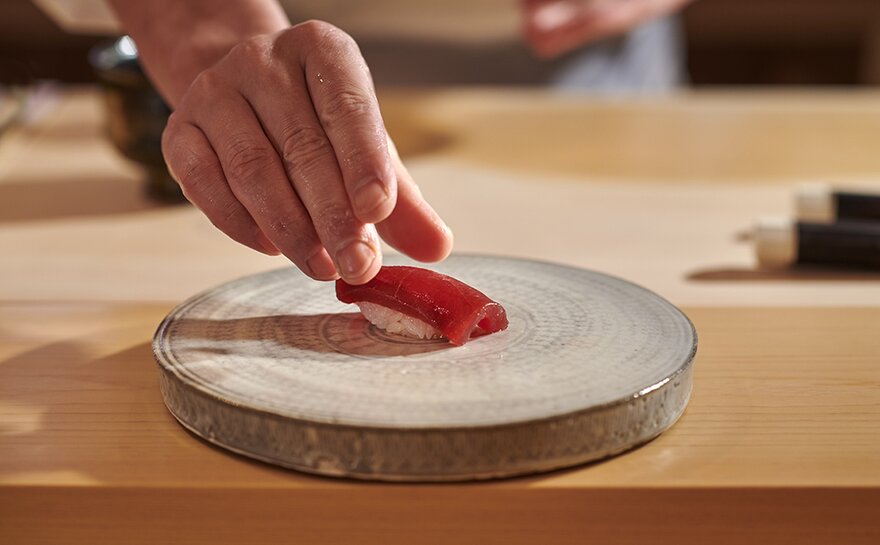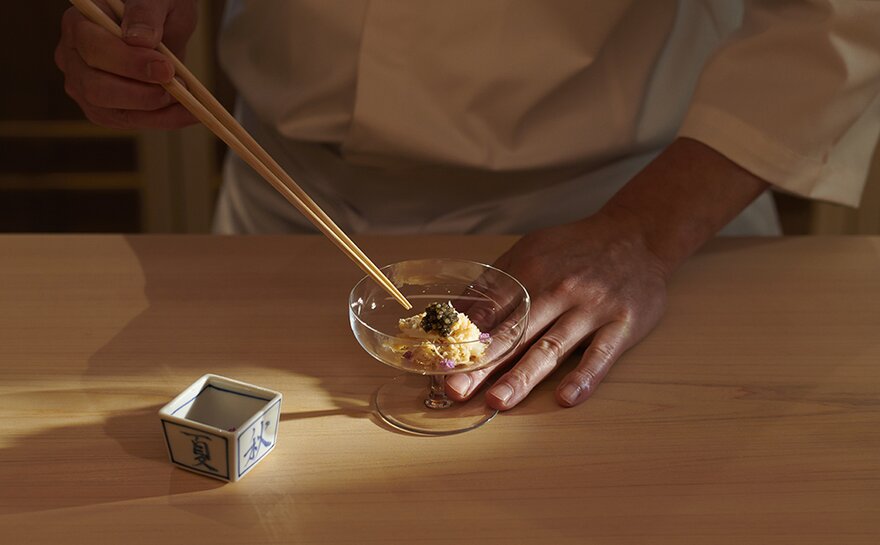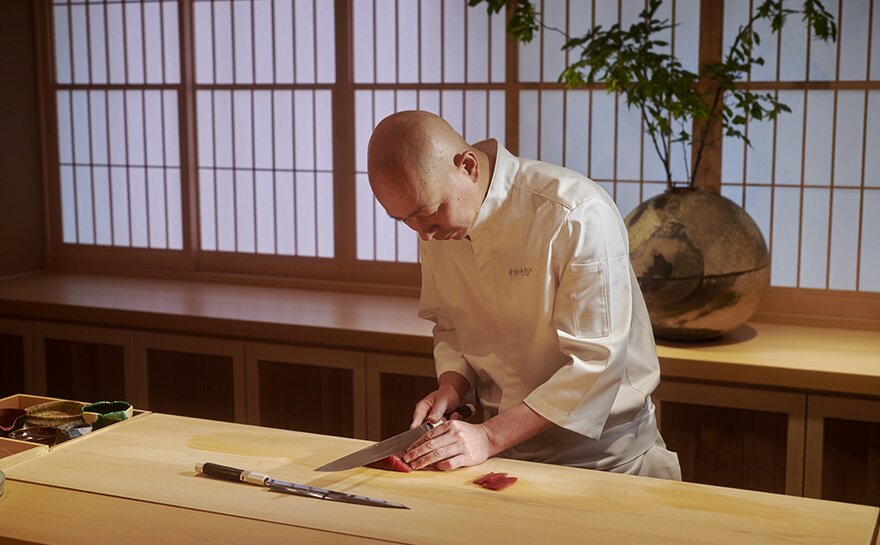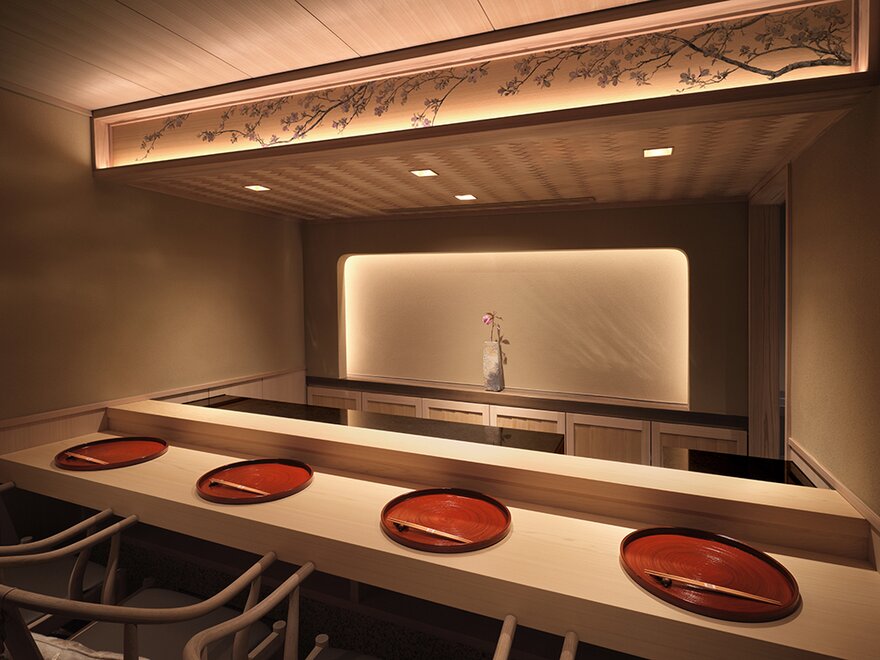Omakase, where diners hand over the responsibility to the sushi chef, creates a very personal and luxurious experience – but at a price
Last month a 13-seat omakase counter, charging diners upwards of £400 a head to experience the carefully curated menus of chef Shinji Kanesaka and his team, opened at the Dorchester Collection's 45 Park Lane.
Immediately Sushi Kanesaka became one of the summer's most written-about openings, with column inches dedicated to the intricate preparation of the finest seafood, the melting texture of the kobe beef and the succulent Japanese fruits that concluded the menu.
Of equal intrigue was the careful staging of the two-hour experience, including an insistence on punctuality and requests that diners not wear perfume. And then, of course, there was the price tag.
Omakase counters have been opening with increasing frequency for some time and Mayfair appears to be the epicentre, perhaps unsurprisingly given that a conservative meal can easily cost in excess of £200 a person. The term omakase translates to "I'll leave it up to you", with the chef determining a menu that can stretch to 20 courses, typically served to a small group of diners sat at a counter.
Tomoko Hasegawa, joint head chef of Roji in Mayfair with Tamas Naszai, says: "There's a misconception that omakase means expensive sushi. In Japan you can have omakase in many kinds of restaurants, including pizza restaurants. To us, it means trust. You must trust that the chef is going to truly look after you and present the best ingredients and dishes they can."
The quality of the produce and the techniques used to prepare it are, of course, pivotal. Andre Aguiar, head sushi chef at Musu in Manchester, who trained with Japanese master Yugo Kato, explains: "There's a lot behind a piece of sushi. It's rice and fish, but there's more. When the customer comes to the counter I show them the sushi box containing the fillets and seafood. It's more like an educational journey. I explain every single dish to them. For example, when I serve sashimi I tell them ‘This is bluefin tuna, it comes from Spain, it's been aged for 10 or 12 or 15 days and is cured in kombu'. Then I'll explain the preparation, what cut I'm using and why that type of cut enhances the flavour. It's all in the details."
An omakase menu can change daily in accordance with the produce the restaurant receives. The preparation may be adapted or a course can be dropped entirely if the seafood is not considered up to scratch.
Naszai says: "We only work with suppliers who have integrity in what they do. We've met many of them face-to-face and to see their dedication to quality and sustainability is very important to us. As many of our ingredients are only in season for a short space of time it's important we keep up the relationship with them. For example, our sea urchin comes from a fisherman in Donegal, Ireland. He picks the urchin in the day and couriers it to us overnight still alive. Without that relationship and trust we wouldn't get such an amazing product."
Good rice is key to great sushi
Of equal importance to the seafood, meat or vegetables is the rice. In fact, Kanesaka, whose eponymous Tokyo restaurant has held two Michelin stars since 2018, describes the rice used by a restaurant as a "lifeline". He uses the same combination of grains in London as Tokyo, and when pressed for details explains that it is a closely guarded secret and something that is particular to each restaurant – almost a signature of a sushi master.
He adds: "The main thing always has to be the rice. The fish and the sauce have to support the flavour of the rice. It has to come together in your mouth, so the focus is still the rice."
Echoing Aguiar, he examines produce daily and can expect two or three dishes to change as a result. Sushi Kanesaka sources seafood, including blue lobsters, from Cornwall, scallops from Orkney as well as produce from Ireland, Spain and Portugal. All of this will determine the menu on a given day. Hasegawa explains that he and Naszai like to showcase various cooking techniques across a service – raw, steamed, simmered, grilled and fried – aiming to achieve a flow that allows the "flavours of the ingredients to shine through".
To allow those delicate distinctions in flavour to be appreciated by diners, the order of the dishes is carefully curated, ensuring tastebuds are not overwhelmed, as Kanesaka says: "If it is all strong flavours your palate will become tired. It's like a relationship: if someone is pursuing you too much, you get tired."
For Aguiar the menu should gain momentum through the courses. He explains: "I always think about it like a flight. We start very slow and then go faster and faster until you're flying up. I like to offer something very nice and fresh [at the beginning] and then increase the flavours, so we start with lean fish and it gets fattier and the textures evolve and then at the end you have the more umami and stronger flavours, like wagyu beef with truffle.
"If I gave you wagyu with truffle at the beginning your tongue would be covered with oil and you wouldn't be able to appreciate something like madai, which is a Japanese bream with a very fresh and subtle flavour."
Seasoning is also key and Kanesaka explains that this is one of the ways he balances the flow of the meal, allowing the delicate flavours of the fish, such as the subtle sweetness of skate, to shine through.
Vinegar is used to season the sushi rice but, as Aguiar explains, it's quite different to the stuff you shake on your chips. All the vinegar and soy sauce he uses is imported from Japan. The rice vinegar is akazu, which dates back to the 1600s and is aged in wooden barrels for five to 10 years. He adds: "It develops more of a caramel colour, it's sweeter and more umami."
At Sushi Kanesaka guests are asked not to wear perfume because it could interfere with the aroma of the vinegar. This may seem like a strange and ever rather pedantic request, but key to the appreciation of an omakase experience is the engaging of all the senses.
Aguiar explains: "The experience starts with the appearance. It has to look beautiful so the customer is amazed and then after that it's the smell. When I'm torching the wagyu beef customers smell the beautiful aroma that is released; when they touch the sushi the rice is warm and the fish is fresh. I recommend that people to eat with their hands.
"It's about using all the senses to create an experience they will not forget easily. They've watched every step and every slice of fish and really connected with the food. It's like a chefs' table but it's more intimate."
For Hasegawa and Naszai it's not just the dishes themselves that can engage the senses but everything the guest encounters. Hasegawa adds: "It's not just the season of the produce but also how the dish looks and what it is served on. We make a lot of our own crockery so that the look and feel is just right for each dish and the season is celebrated as well as it can be."
Japanese omakase in 45 Park Lane
For Lee Kelly, general manager of 45 Park Lane, an omakase counter has been a fantastic addition, occupying a space previously used as a private dining room and known as the Media Room. He says: "When we thought about putting this together in terms of the space, we felt it was a natural fit for a Japanese omakase experience. It was a perfect marriage for us, and then when we wanted to partner with a chef it was natural for us to approach Kanesaka. He is a master of sushi and incredibly well known – it's worked out perfectly.
"It's definitely made some noise, which is incredible. We couldn't be happier with what's happened so far. It's a continuing evolution and a journey."
A month before Sushi Kanesaka opened at 45 Park Lane, another omakase counter opened at the Prince Akatoki hotel in Marylebone in London, offering an 11-dish menu served at a six-seat counter at £100 a head.
Chef Alex Ghetau serves creative fusions on traditional dishes, incorporating ingredients such as wagyu beef and fatty tuna. He explains: "We saw that there wasn't a mid-range omakase experience in London. They were either very cheap and not really omakase experiences, or at the high end at £200 or more. We wanted to do something that was more accessible, to give people an idea of that experience, so we've reduced the number of courses, but we're still serving some amazing produce, such as the wagyu beef."
The website for Sushi Kanesaka reads: "Omakase dining means knowing the very finest delicacies, the most exquisite tastes of the moment, are to be chosen by a master in the art. Relinquishing choice adds delicious mystery to the moment. It allows the chef's pursuit of perfection to create something uniquely personal, it builds the anticipation of each bite, and forges a rare and intimate connection between chef and diner."
Such intoxicating experiences are attracting diners across the country, and for Aguiar the guests' desire for greater connection with their food is served perfectly by the Japanese tradition. He adds: "Customers are looking for more intimate dining, and when you sit at the counter you feel special and that the food is very important. The experience is also borne out in the taste. If you try food at the table [in the restaurant] and then try it at the sushi counter, it tastes different because five seconds after it has been made it starts to change. Time is so important. The rice needs to be a little bit warm and the fish needs to be freshly cut. It will always taste 10 times better at the counter."
The sushi masters' signature dishes
Tomoko Hasegawa and Tamas Naszai, Roji in London
Our scallop dish (isobe-age, or wrapped in seaweed and briefly deep-fried) has definitely become one of our signature courses and has stayed on the menu from day one. The sweet Scottish scallop really comes to life in that dish. We also both love our homemade ice-cream. We change the flavour with the seasons and it's a great treat after service, if there's any left!
Andre Aguiar, head sushi chef, Musu in Manchester
My signature nigiri is the Carabinero prawn topped with miso butter. It's one of our customers' favourites due to the high-quality sweet red prawns from the Mediterranean Sea. I use 100% of the prawn to make the dish: the body to make the nigiri and the head and shells to make the miso butter.
Shinji Kanesaka of Sushi Kanesaka, 45 Park Lane, London:
A sushi of marinated akami [part of a blue fin tuna that yields lean red meat cut from the upper part of the back]
Continue reading
You need to be a premium member to view this. Subscribe from just 99p per week.
Already subscribed? Log In








